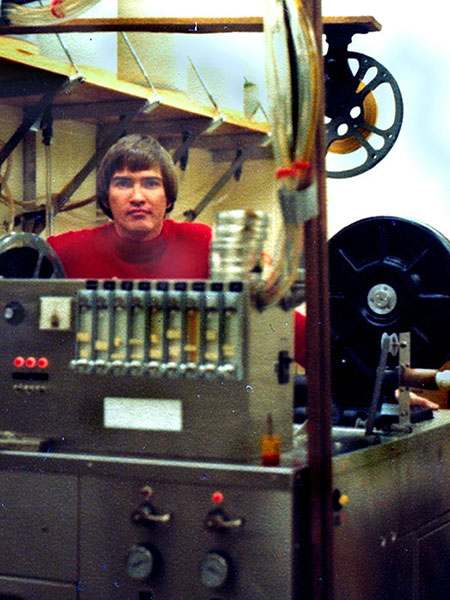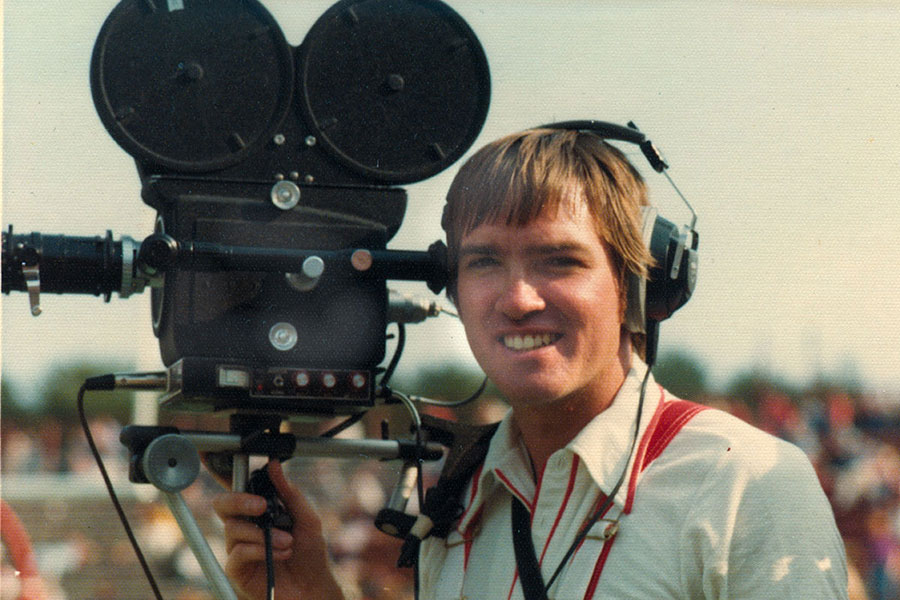Educational film major Al Edyvean, BA’72, MS’75, spent much of the 1970s behind a camera—filming social gatherings and sporting events on the Bloomington campus for the IU News Bureau and the IU Athletics Department.

He shot and edited all football and basketball highlight films from 1971–78. He filmed 122 TV halftime shows—two-minute clips that covered subjects representing the best of IU, including alumnus Mark Spitz, ’72, winning seven gold medals in the 1972 Olympics, and how IU—at the time—held the patent on Crest toothpaste. Several of the clips were aired as part of NBC’s Game of the Week, gaining national recognition for IU.
Yet Edyvean’s career in media almost never got started. After taking a news-film production class his sophomore year, Edyvean learned there were no other film courses available to undergraduates. IU eventually allowed him to enroll in graduate courses. But there was a caveat—he had to have his own camera.
“So, I went looking for film equipment on campus,” he said. “In those days, the athletics department shot basketball and football games and daily practices on 16mm film. They had a film processing lab at the newly built Assembly Hall and more equipment than they could possibly use. I went to see the IU Athletics photographer, Dick Bundy, and asked if I could borrow one of his 16mm cameras. I’ll never forget what he said: ‘Boy, there’s only two things I never lend—and that’s my cameras and my wife!’”
Still, Bundy hired Edyvean to be his assistant. They worked together in the university’s film lab for the next 10 years, processing game films and still photos of athletes across the board, including women’s varsity sports, which weren’t fully recognized until Title IX was enacted on June 23, 1972.
Edyvean also wrote, filmed, and directed The Freshman Experience, his senior project that became IU’s go-to orientation film from 1972–80. It was so successful that Edyvean traveled to many high schools to show the film and answer questions about IU, including about the then-controversial “open visitation” policy allowing men in women’s dorms and vice versa.
In the following Q&A, Edyvean talks about his time at IU and the three films he made while a student on the Bloomington campus.
What inspired you to pursue a career in media?
Al Edyvean: I went to IU to major in theater because my father ran the Edyvean Repertory Theatre in Indianapolis. In my first semester, someone in the theater department told me, “You’re not a senior, so you won’t be in any shows for three more years.” So, I changed my major.
You worked at the IU News Bureau. Can you talk about that experience?
AE: In my junior year, I was asked by the man who taught my news film class, Robert Petranoff, BA’48, MS’63, who also worked for the IU News Bureau, to help him shoot news clips to send to the three local news stations (Channels 6, 8, and 13) in Indianapolis. This started with weekly clips from the IU School of Business. We’d talk to a professor who would give us the economic report for Indiana or interpret the week’s stock market.
Tell us about your senior film project, The Freshman Experience.
AE: I went to [University Division] and said, “I need to do a film for my senior year, and you guys need an orientation film, and I would like to make one for you.” And I think I just piqued their interest. I said, “You guys need a film. You can’t do this university justice walking around with a bus tour or having somebody stand in a high school and say, it’s a great place to come, read this brochure. That’s crazy.” The University Division guy said, “Well, that’s a good idea. What would it cost to do that?” And I said, “Well, about 30 grand. And he took a deep breath and said, okay, give me a day,” and came back and said, “I think that’s great. Let’s just do it.”
When the film was released in the spring of 1972, I was asked to go on the road with it to many of the high schools [in and around the state of Indiana]. I was sort of the “young filmmaker” that could comment on the questions that students and parents had about the campus.
One of the hot topics at the time was the beginning of men and women being allowed in each other’s dorms on Friday and Saturday nights. It was called open visitation and if each floor in the dorm voted on this at the beginning of the semester, then men were allowed on that floor of women and/or women would be allowed on that floor of men.
This was a new policy as IU was unofficially moving away from its former policy of “in loco parentis,” which is Latin for “in the place of the parent.” In those days when a student went to college, the university was officially watching over them “in loco parentis.”
Well, IU wanted me to explain this to parents and students without saying the obvious, which was, “We have decided to let students get together in each other’s rooms because they are adults, and they can do that.”
So, this went on for over a year, at which time it began to get old. I asked to be relieved of this duty, but they were getting great [recruiting] results with me and with the film, so they pushed me to stay on. Finally, I was too busy, and they kept pushing and scheduling me. So, on the next trip when a parent asked me about open visitation and said: “Is it true that the university will let young men come onto my daughter’s dormitory floor?” And I said: “Yes ma’am.”
Then she said: “But will they be allowed to come into her room?” And I said: “Ma’am, in their infinite wisdom, the Board of Trustees at IU has decided to take sex out of the back seats of cars on campus and put it back in the dorm rooms where it belongs!” And that was the last personal appearance I made for University Division and Admissions.
